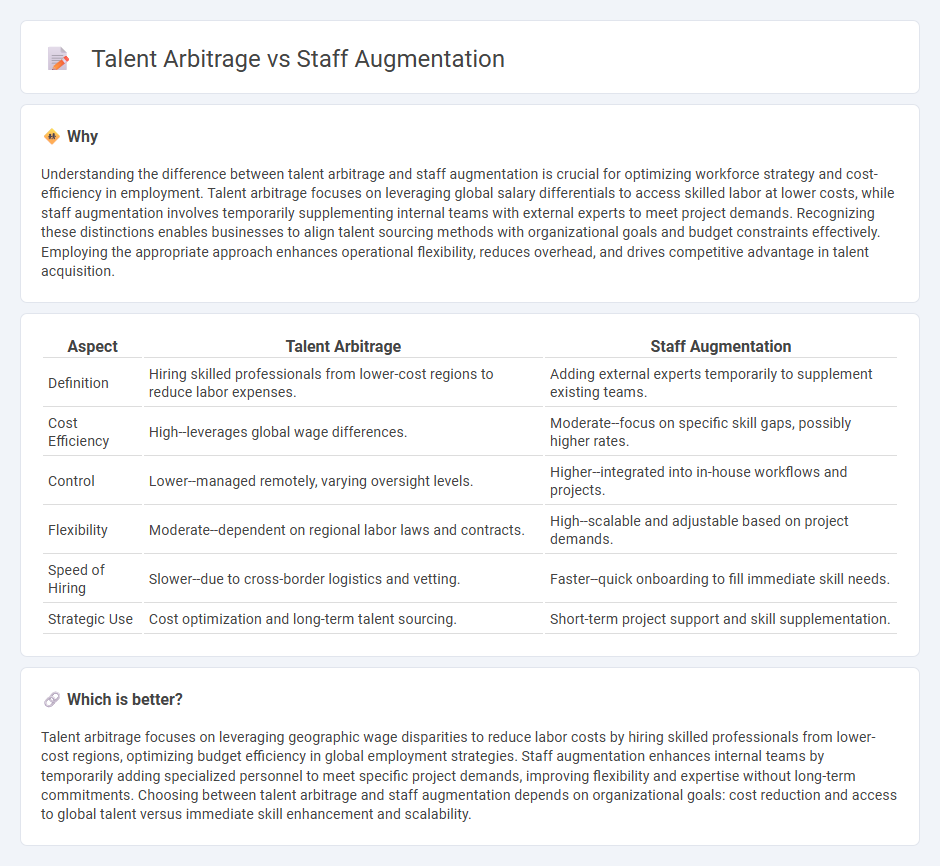
Talent arbitrage leverages global wage disparities by outsourcing skilled positions to lower-cost regions, optimizing labor costs and enhancing competitive advantage. Staff augmentation supplements existing teams with external professionals to meet project demands without long-term commitments, ensuring flexibility and scalability. Discover how businesses strategically balance these approaches to maximize workforce efficiency.
Why it is important
Understanding the difference between talent arbitrage and staff augmentation is crucial for optimizing workforce strategy and cost-efficiency in employment. Talent arbitrage focuses on leveraging global salary differentials to access skilled labor at lower costs, while staff augmentation involves temporarily supplementing internal teams with external experts to meet project demands. Recognizing these distinctions enables businesses to align talent sourcing methods with organizational goals and budget constraints effectively. Employing the appropriate approach enhances operational flexibility, reduces overhead, and drives competitive advantage in talent acquisition.
Comparison Table
| Aspect | Talent Arbitrage | Staff Augmentation |
|---|---|---|
| Definition | Hiring skilled professionals from lower-cost regions to reduce labor expenses. | Adding external experts temporarily to supplement existing teams. |
| Cost Efficiency | High--leverages global wage differences. | Moderate--focus on specific skill gaps, possibly higher rates. |
| Control | Lower--managed remotely, varying oversight levels. | Higher--integrated into in-house workflows and projects. |
| Flexibility | Moderate--dependent on regional labor laws and contracts. | High--scalable and adjustable based on project demands. |
| Speed of Hiring | Slower--due to cross-border logistics and vetting. | Faster--quick onboarding to fill immediate skill needs. |
| Strategic Use | Cost optimization and long-term talent sourcing. | Short-term project support and skill supplementation. |
Which is better?
Talent arbitrage focuses on leveraging geographic wage disparities to reduce labor costs by hiring skilled professionals from lower-cost regions, optimizing budget efficiency in global employment strategies. Staff augmentation enhances internal teams by temporarily adding specialized personnel to meet specific project demands, improving flexibility and expertise without long-term commitments. Choosing between talent arbitrage and staff augmentation depends on organizational goals: cost reduction and access to global talent versus immediate skill enhancement and scalability.
Connection
Talent arbitrage leverages cost-effective access to skilled professionals across global markets, enabling companies to optimize labor expenses while maintaining high-quality output. Staff augmentation complements this strategy by providing flexible workforce scaling through the integration of external experts, facilitating rapid response to changing project demands. Together, these practices enhance organizational agility, driving competitive advantage in talent acquisition and employment cost management.
Key Terms
Resource Flexibility
Staff augmentation provides resource flexibility by allowing companies to scale their workforce quickly with specialized professionals on a temporary basis, adapting to project demands without long-term commitments. Talent arbitrage focuses on cost efficiency by outsourcing roles to regions with lower labor costs, which may limit immediate flexibility but offer financial advantages. Explore how these approaches impact your resource strategy to make informed decisions.
Cost Efficiency
Staff augmentation allows companies to scale their workforce flexibly by hiring skilled professionals on a temporary basis, optimizing operational costs without long-term commitments. Talent arbitrage leverages geographical wage differences to outsource tasks to lower-cost regions, maximizing budget efficiency while maintaining quality standards. Explore detailed comparisons to discover which strategy best enhances your cost efficiency and business goals.
Skill Accessibility
Staff augmentation enhances project flexibility by integrating skilled professionals directly into existing teams, ensuring immediate access to specialized expertise. Talent arbitrage leverages cost-efficient sourcing from global markets, prioritizing budget optimization while accessing a diverse talent pool. Discover more about optimizing skill accessibility strategies for your business needs.
Source and External Links
Pros and Cons of Staff Augmentation : A Detailed Look - TechGenies - Staff augmentation is a staffing model where a business hires external professionals temporarily to support specific projects, providing flexibility and access to specialized skills to accelerate growth, but it requires careful management of integration and costs.
Staff augmentation - Wikipedia - Staff augmentation is an outsourcing strategy used to supplement a company's existing staff with external contract workers to meet project demands and business objectives.
What is Staff Augmentation? Benefits and Best Practices - Adevait - Staff augmentation is a flexible outsourcing approach allowing companies to hire external talent to work alongside full-time employees, often used to fill skill gaps quickly and cost-effectively.
 dowidth.com
dowidth.com